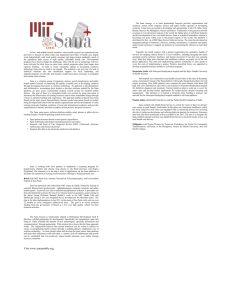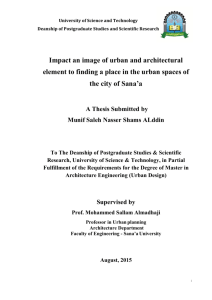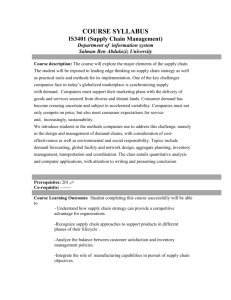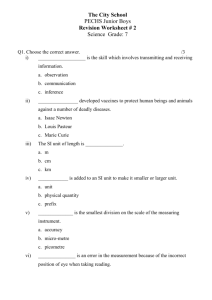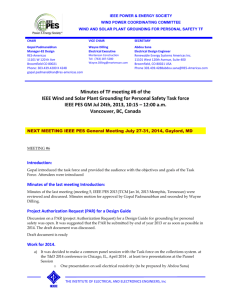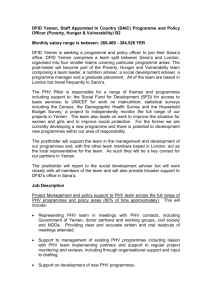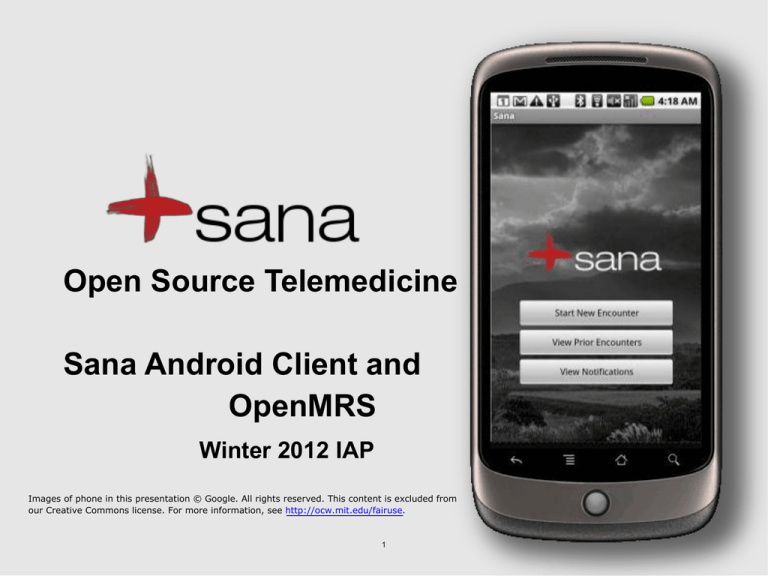
Open Source Telemedicine
Sana Android Client and
OpenMRS
Winter 2012 IAP
Images of phone in this presentation © Google. All rights reserved. This content is excluded from
our Creative Commons license. For more information, see http://ocw.mit.edu/fairuse.
1
Course Agenda
General introduction to the platform
How to get started developing
Platform software components
Topics related to the software
Guest speakers.
Case studies and related topics
Hands on projects
Plans for the future
2
Daily Schedule
Day
Agenda
Jan 26th
Introduction to the platform
Development Environment
Guest Speaker: Dr. Trishan Panch, Clinical
perspectives on software tools
Jan 27th
Sana Android Client
Project Discussion
Guest Speaker: Members of hearing loss study
from UFRN, Rio Grande Norte, Brazil
Jan 30th
Jan 31st
Feb 1st
Data Layer: Client and Permanent Data Stores, OpenMRS
Guest Speaker: Chris Moses, Cardiovascular
disease study, Philippines
Dispatch layer
Guest Speaker: Rich Fletcher, Medical Device Integration
Hacking Day
Systems and Scalability: Platform based approach
Hacking day
Feb 2nd
Hacking day
Feb 3rd
Wrap up
Participant project3 presentations
Open Source Telemedicine
Introduction
4
Agenda
Fundamental problem
Goals
Challenges
Why Sana?
Solutions
5
Fundamental Problem
Given a shortage of trained clinical specialists
coupled with limitations on connectivity and a
myriad of local challenges, how do we effectively
project medical decision support and expertise
into remote areas to capture and store data for
future use as well as provide follow up
instructions for care?
6
General Goals
Measurable outcomes.
High availability.
Cost Efficiency.
Interoperability.
Customizable.
7
Challenges
1. Physical barriers
Physical access may be difficult.
2. Technical barriers
Connectivity can be poor or intermittent.
3. Cultural and language barriers
Users will expect compliance with local and cultural
norms.
4. Technical skill barriers
User experience can limit adoption
5. Financial Barriers
Cost of adoption may be prohibitive
8
Assumptions
Technology can provide a path to addressing a
number of the challenges.
Technology alone will not solve the problems.
No one group has all of the necessary skill and
expertise.
Collaborative innovation is necessary to
address the wide range of local issues that face
healthcare access and delivery
Education of health providers as well as those
managing healthcare systems is critical to long
term success.
9
Our Approach
Technology
Education
Collaboration
10
Addressing Challenges
Physical barriers
Fundamentally, mobile networks provide increased
connectivity into areas that were previously more
difficult to access.
Technical barriers
Given poor or intermittent connectivity, mobile networks
alone are not a perfect solution. We employ a
combination of techniques which react to local
conditions and use a retry-on-fail approach to maintain
high availability.
Integrates with other 3rd party Android apps.
11
Addressing Challenges
Cultural and language barriers
Components that can be localized.
Education and information resources can be modified to
adapt to local norms.
Technical skill barriers
Provide end users with an intuitive user interface.
Use a reasonably simple document format for any that
may need to be edited by end users.
Financial Barriers
All components are freely available.
Components are compatible with low-grade hardware to
the greatest extent possible.
12
Sana Tech Solution
Provide a turn-key, open source, platform
consisting of a mobile client, network transport
layer, and permanent data store for collecting
and moving data from remote areas to
centralized clinical specialists and back.
13
Sana Solution
Workflow
1. Data collection instructions are provided to a
Clinical Health Worker, CHW, on a mobile device.
2. CHW collects data following those instructions.
3. Collected data is sent to a centralized medical
records system.
4. Data is reviewed by a clinical specialist.
5. Notification of diagnosis and follow up
instructions are returned to CHW.
14
Open Source Telemedicine
Platform Overview
15
Sana Platform
Dispatcher
Data Store
Client
16
Sana Platform
Python
Django
Mobile Client
System
(Android)
Mobile Dispatch Server
Medical Records
(Java, OpenMRS)
17
Sana Mobile Client
Dispatcher
Network Layer
Procedure
Engine
Android APIs
Client
Data Store
SQLite
UI Layer
18
Mobile Dispatch Server
Dispatcher
Web Server
SMS Client
Email Client
Data Store
Caching
MySQL
Client
Http Request
19
OpenMRS Modules
Dispatcher
Sana Module
Tomcat
Webapp
Client
Http Request
Data Store
MySQL
20
Design Patterns
Logos © Python, Django, OpenMRS. All rights reserved. This content is excluded from
our Creative Commons license. For more information, see http://ocw.mit.edu/fairuse.
21
Sana Platform
Operating System
Ubuntu OS + Sana Packages
Sana provides prebuilt packages for Ubuntu – a
Linux based OS
22
Sana Platform
Why Open Source?
1. Reduces financial barriers.
2. Freedom to modify and adapt to our needs.
3. Open standards.
23
Open Source Telemedicine
Workflow
24
Sana Platform
Workflow Implementation
Supports text and binary data
Customizable decision trees
Integrated with digital medical records system
Optimized data transfer for poor coverage areas
CHW collects data and uploads over GPRS, 3G, or Wifi
Clinical Specialist reviews encounter through OpenMRS and sends
notification back to the mobile client
25
Sana Platform
Android Client
1. CHW Instructions are form based –
XML
2. GUI layer interprets instructions into
more user friendly format – buttons, etc.
3. Integrates with full data capture
capabilities of device.
4. Integrates device capabilities for patient
education and CHW instruction.
5. Local data storage.
6. Agile and secure network layer.
26
Sana Platform
Sana XML Forms
1. Step wise data collection using markup
language.
2. Collection of specific data types.
3. Conditional branching logic.
4. Required constraint.
5. Plugins
27
Sana Platform
Example:
Sana XML Forms
<Procedure title="Example" author="Sana">
<Page>
<Element type="RADIO" id="1" concept="TEST SELECT ONE"
question="Demonstrate selecting a single value"
answer="1" choices="1,2,3,4" required="true"/>
</Page>
<Page>
<ShowIf>
<Criteria type="EQUALS" id="1" value="4"/>
</ShowIf>
<Element type="PLUGIN" id="2" concept="SUBJECT VIDEO"
question="Video media file for patient encounter"
action="android.media.action.VIDEO_CAPTURE"
mimeType="video/*" answer="" />
</Page>
</Procedure>
28
Sana Platform
Mobile Dispatch Server, MDS
1. Connection Based REST API-JSON formatted HTTP requests.
2. Supports packetization
3. Communicates with EMR
4. Sends SMS and email notifications
5. Typically configured to run on same server as EMR
29
Sana Platform
Encounter upload example
POST mds encounter url
upload url
Request params:
Params:
Encounter identifier
Encounter identifier
Client id
Client id
Authorization
Authorization
Collected Data
Collected Data
POST OpenMRS
Recieves “OK” from MDS
to MDS
Responds “OK”
Request
30
Sana Platform
Dispatch Server
Packetization Implementation
1. Client sends binary data as smaller file POST requests.
2. Client algorithm will reduce packet size based on network
conditions.
3. Mobile client will retry on fail.
31
Sana Platform
OpenMRS
Free, Open Source EMR
•Active deployments globally
•Deployed as Tomcat web application
•Extensive plug-in system
•
32
Sana OpenMRS Modules
•
Sana Queue Module
- Supports uploads from MDS
•
- Stores uploaded encounter data directly into the OpenMRS tables
•
- Stores a queue table in the OpenMRS database, linked to
OpenMRS
•
Encounter table
•
- Provides views of items waiting to be reviewed as a queue
•
•
•
•
Media Viewer Module
- Flash/JS based visualizer for rich media content
REST Module
- RESTful access to the OpenMRS data model
33
Sana Platform Scalability
Target baseline is to be compatible with OpenMRS
performance.
Platform capable of handling thousands of patient
encounters/reviews daily including significant binary
content.
Additional content/plugins can be added at run time
34
Open Source Telemedicine
Roadmap
35
Going forward
Generic architecture applicable to any
areas that may suffer from differential
access to skilled personnel and provides
analysis.
1. Generalized analytics API
2. Common language.
3. User land tools.
4. Ready made systems.
36
Going Forward
Issues and areas of research. Examples
1. Ease of Use
Examples:
- WYSIWYG Form builders
- Automatic client content updates
2. Administration
Examples:
- Conten/tPackage Management
Central repositories for content and diagnostic tools
- Network diagnostic tools
- Remote client management
3. Network Architecture
Examples:
- Increased support for varied network topologies
- Load balancing
4. UI independent analytics libraries
- jSana, pySana
37
Going forward
How to get involved
1. Join the mailing lists.
2. Attend the development workshops and
meetings.
3. Attend the general meetings.
4. Let us know about yourself.
5. Check out the code.
6. Have fun and remember that work you do for
Sana does have a direct impact.
38
Additional Information
Sana Wiki
Additional details are available on the Sana Wiki:
http://sana.mit.edu/wiki
Includes installation and configuration for
developers and end users.
39
MIT OpenCourseWare
http://ocw.mit.edu
HST.S14 Health Information Systems to Improve Quality of Care in Resource-Poor Settings
Spring 2012
For information about citing these materials or our Terms of Use, visit: http://ocw.mit.edu/terms.

